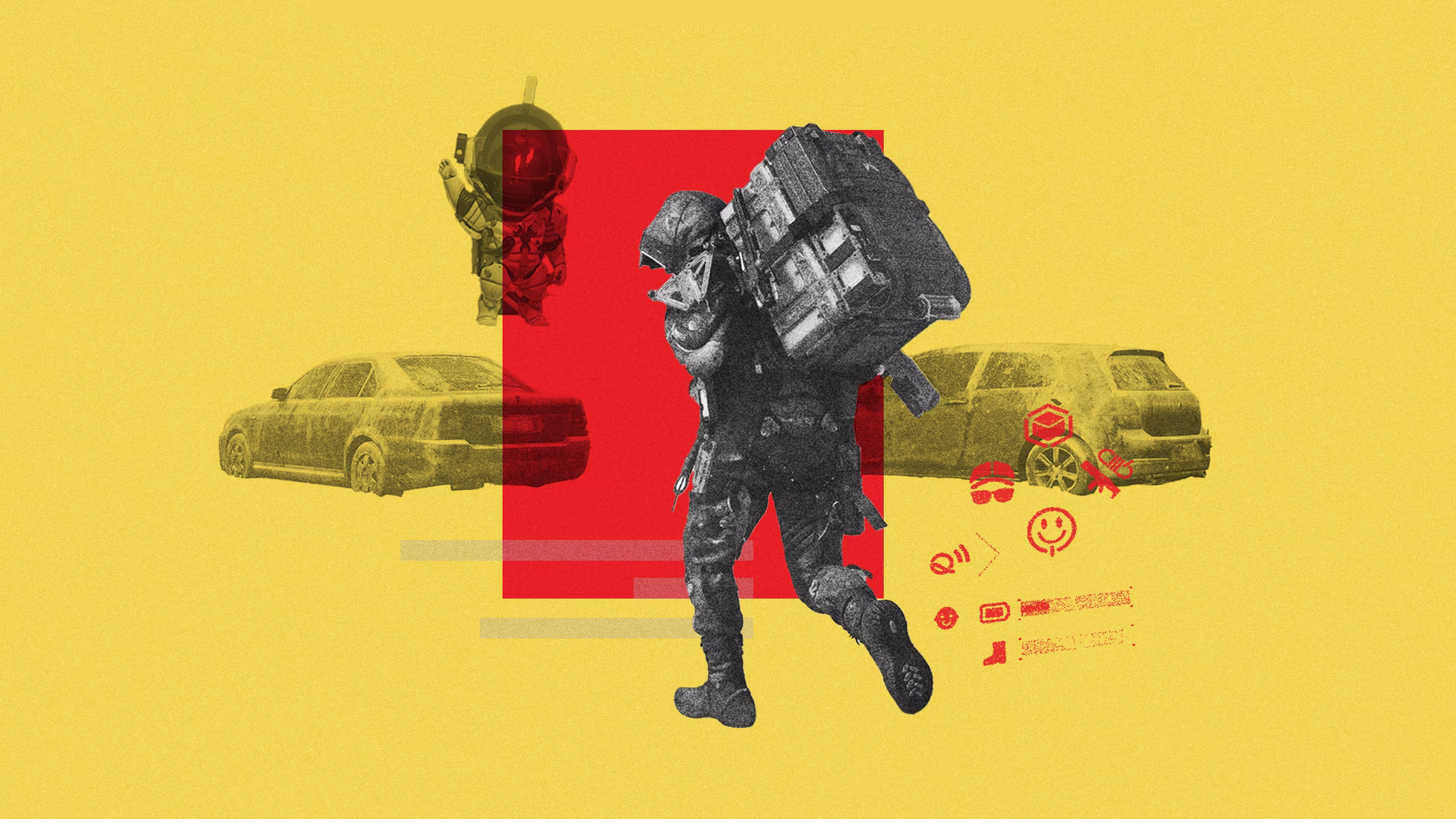In a surprising twist, one of the most anticipated video games of the year, Hideo Kojima’s Death Stranding 2: On the Beach, casts players in a role strikingly similar to an Amazon delivery driver.
This seemingly mundane premise, however, serves as a rich canvas for a profound exploration of modern anxieties. Unlike typical action-packed blockbusters such as Call of Duty or Helldivers, where players embody invincible super-soldiers, Death Stranding 2 immerses you in the challenging, often unglamorous reality of a courier.
You will find yourself meticulously arranging precarious stacks of packages on your character’s back, navigating treacherous terrain, and even facing financial penalties if your precious cargo is damaged during a stumble. This grounded approach, even with occasional battles against spectral marauders from parallel dimensions, sets it apart from the high-octane titles dominating sales charts.
The game is the brainchild of Hideo Kojima, one of the few directors in the video game medium who has achieved household name status. In Death Stranding 2, players assume the role of Sam Porter Bridges, a character whose voice and likeness are remarkably brought to life by Norman Reedus, known for his work in The Walking Dead.
Sam is depicted as a dour, unsmiling courier, burdened by the weight of a shattered world. Kojima’s rugged vision of the future portrays much of human civilization and its essential infrastructure as destroyed. Society has fractured into isolated pockets of survivors. These disparate communities are only tenuously connected by dedicated delivery personnel, who bravely haul vital essentials between them. Furthermore, these couriers are responsible for linking these isolated hubs to the game’s fictional rendition of the internet, known as the Chiral Network. In essence, players become a fascinating hybrid: a perpetually haunted Amazon deliveryman crossed with a pioneering telecommunications engineer.
The Game’s Core Mechanics: A Physically Demanding Journey
The gameplay of Death Stranding 2 is built upon a foundation of challenging traversal and meticulous resource management, designed to highlight the physicality of the courier’s role.
Mastering the Art of Delivery
The central gameplay loop in Death Stranding 2 revolves around delivering packages across vast, unforgiving landscapes. This is not a simple point-and-click affair. Players must constantly manage Sam’s balance, using the controller’s left and right shoulder buttons to shift weight and prevent tumbles, especially when navigating rocky hills or steep inclines. The weight and distribution of packages directly impact Sam’s stability and stamina. Overburdening Sam can lead to slower movement, more frequent stumbles, and greater fatigue. Conversely, carefully balancing the load allows for more efficient and safer traversal.
The game meticulously simulates physical interactions, meaning that a carelessly placed foot or an ill-timed sprint can result in a loss of balance, a damaging fall, and costly penalties for scuffed merchandise.
Beyond simply walking, early missions see Sam making his first deliveries entirely on foot. Players must strategically use ladders to bridge rivers and climbing gear to rappel down mountains. These tools are not limitless; players must plan their routes meticulously, anticipating geographical challenges and packing the necessary equipment. The “slog across rugged Mexico,” as described in early previews, emphasizes the arduous nature of these treks.
The environment itself is a formidable adversary, with dynamic weather patterns, terrain degradation, and new environmental dangers like quicksand-like grounds and shaky cliffs, all impacting routes and demanding improvisation. Every step, every choice of equipment, and every tactical decision about the path forward directly influences the success and safety of the delivery.
Interacting with a Fractured World
Upon reaching a destination in Death Stranding 2, players are typically not greeted by live residents. Instead, they interact with hologram versions of the community’s inhabitants. These holograms communicate as if through a digital doorbell, a subtle yet potent parallel to modern technologies like Ring cameras, which postal workers increasingly interact with in today’s world.
This form of interaction underscores one of the game’s central themes: the erosion of direct human intimacy by digital substitutes. Despite the lack of physical presence, these holographic encounters serve a crucial purpose: once a connection is established, players are often given additional errands by these residents.
Beyond new delivery requests, players interact with these communities and other players through a unique, in-game social media platform. This system allows players to “frantically dispense likes by mashing a button on your controller.” These “likes,” while not tangible currency, provide a sense of digital affirmation and appreciation for successful deliveries or helpful actions. A significant collaborative element, known as the “strand” connection system, also makes a return and is greatly expanded.
Whenever Sam brings a settlement onto the metaphorical and literal network, that region comes online. This connectivity then manifests in the player’s own game as the appearance of roads, electric-vehicle charging points, and other useful features that have been previously installed by other Death Stranding 2 players.
This innovative asynchronous multiplayer system means players “profit from the efforts and inputs of others.” Conversely, players can also contribute materials to improve or repair these shared structures when they break down, fostering a sense of collective responsibility and mutual benefit. This ingenious mechanic provides a convincing metaphor for the inherent advantages of living in an interconnected society, where individual contributions collectively build a more navigable and resilient world.
Thematic Depths: Connectivity, Obsolescence, and Humanity
Beyond its unique gameplay, Death Stranding 2 delves into complex philosophical themes, exploring the paradoxes of digital life and the enduring essence of human existence.
The Digital Paradox: Connection vs. Alienation
One of the central anxieties that Kojima explores in Death Stranding 2 is the creeping erosion of human intimacy by digital substitutes. This theme is made starkly evident through the game’s narrative and mechanics. The ability to connect isolated communities via the Chiral Network and interact with residents through holograms highlights the convenience of digital communication.
However, the game subtly, and at times overtly, argues that such virtual interactions are no true replacement for physical presence. A poignant line delivered by a character late in the game, “Communicating with someone via hologram is no substitute for being able to reach out and touch” them, encapsulates this core message.
This digital paradox is further explored as Sam advances in his journey. As Bridges eventually relocates to Australia to connect a new continent, he gains access to off-road vehicles, zip lines, and monorails. These mechanical advances significantly hasten the task of making deliveries across precarious terrains and allow players to transport a greater number of packages and materials.
This acceleration in logistical efficiency precisely mimics the “Amazonification” of society, where increasingly sophisticated technology streamlines delivery processes. This creates a compelling gameplay loop, designed to leave players feeling conflicted: Sam is slowly building himself out of a job by assembling the very tools and systems that will ultimately replace him. This serves as an extended metaphor for modern life’s digital paradox, where technology, ostensibly designed to unite us and simplify our lives, can simultaneously strip interactions of their humanity and invite uncomfortable questions about human obsolescence.
The Threat of Obsolescence and AI
A deeply intertwined anxiety shaping our current moment, and a core theme in Death Stranding 2, is our growing unease about building technologies that might render our own roles obsolete. The advancements in AI and automation are rapidly transforming industries worldwide, prompting uncomfortable questions about who will be displaced by these new technologies. In Death Stranding 2, Sam’s journey mirrors this societal concern.
As he builds the infrastructure and introduces more efficient delivery methods, he is actively contributing to a future where his direct, physically demanding role might no longer be necessary. This self-inflicted obsolescence is a deliberate narrative choice by Kojima, forcing players to confront the implications of technological progress.
The game’s narrative also delves into how digital systems can be co-opted for political purposes by the companies that run them. This warns players about the potential for technology, despite its benefits, to be manipulated and to exert undue influence. Furthermore, the game explores how the “spectral frisson of virtual likes and online exchanges can, in time, flatten us.” This critique suggests that a life lived predominantly through screens and digital interactions can lead to a hollowing-out of genuine human connection and a superficiality in social engagement.
Kojima, beneath his idiosyncratic storytelling and celebrity cameos, is inviting players to consider how technology can quietly alienate us—not simply from one another, but from our very physical selves. This grounds the game’s sprawling oddness in timely concerns that extend far beyond the digital screens on which it is played.
The Enduring Truth of Physicality and Grief
Despite its futuristic setting and technological themes, Death Stranding 2 remains deeply preoccupied with the physical and emotional elements of humanity. The game frequently grounds the player in Sam’s basic biological needs, emphasizing our inherent physicality. On his delivery routes, Sam must drink from a flask to stay hydrated and can even catch and eat bugs when peckish. A dedicated on-screen gauge provides a readout of his urine levels, a seemingly trivial detail that nonetheless reinforces his corporeal reality.
At the end of each strenuous day, Sam returns to his private quarters, where players witness him relieving himself and showering the dust and blood from his body. These deliberate moments serve as stark reminders that “We are physical beings,” who defecate, eat, need sleep, and require water. Unlike many video game protagonists who are often depicted as tireless ciphers, Sam Porter Bridges is decidedly human; he will even become sunburned if he stays too long at work, forcing players to consider his vulnerability and limits.
Beyond the physical, Kojima is also deeply concerned with the spiritual and emotional elements of humanity, particularly grief and loss. Early in Death Stranding 2, Sam suffers a profound emotional loss that dramatically distorts his reality. This trauma manifests as persistent hallucinations and night terrors that shadow him throughout the game. While wounding a character in such a blunt way could, in the hands of a less skilled writer, feel like a cheap attempt at profundity, the depiction in Death Stranding 2 lands with the raw weight of lived experience.
Kojima has recently spoken openly about his own childhood experience with grief. In a recorded conversation with Danish film director Nicolas Winding Refn (who also has a cameo in Death Stranding 2), Kojima shared the deeply personal story of his father’s sudden death when Kojima was just 13. He recounted accompanying his father in the ambulance, recalling, “His eyes were open, but he could not talk because his body was shaking. I think he was trying to tell me something, but I did not know what he wanted to say. After that, I did not have a father.” This profound personal experience undoubtedly imbues Sam’s grief with a powerful authenticity, making his emotional journey resonate deeply with players.
Poignant Appeal for Balance
In Death Stranding 2, although the presence of other players is subtly suggested through shared items and the asynchronous “social media” likes, Sam Porter Bridges ultimately travels alone. This profound solitude echoes Kojima’s enduring contemplation about what often remains unsaid, even between the closest people, whether they are still alive or lost to death. By its conclusion, Death Stranding 2 feels less like a harsh rebuke of digital life and more like a deeply poignant appeal for balance.
Kojima does not simply caution against our increasing reliance on digital technologies. Instead, he reminds us of the fundamental, tactile truths we risk leaving behind in our quest for convenience and virtual connection. The game emphasizes the irreplaceable sensations of “what it feels like to soothe a crying child”, to “shoulder physical burdens,” and crucially, to “exist in the immediate, tangible moment, without a hungry eye on a smartphone screen.”
Through its unique gameplay mechanics and deeply personal narrative, Death Stranding 2 powerfully underscores a vital message: the physical bonds we share with one another, the direct human connections, are easily obscured by the convenient illusions of digital interaction. Yet, despite the pervasive influence of technology, these tangible relationships and shared physical experiences still remain our most meaningful refuge in a transient world and a fleeting existence.







